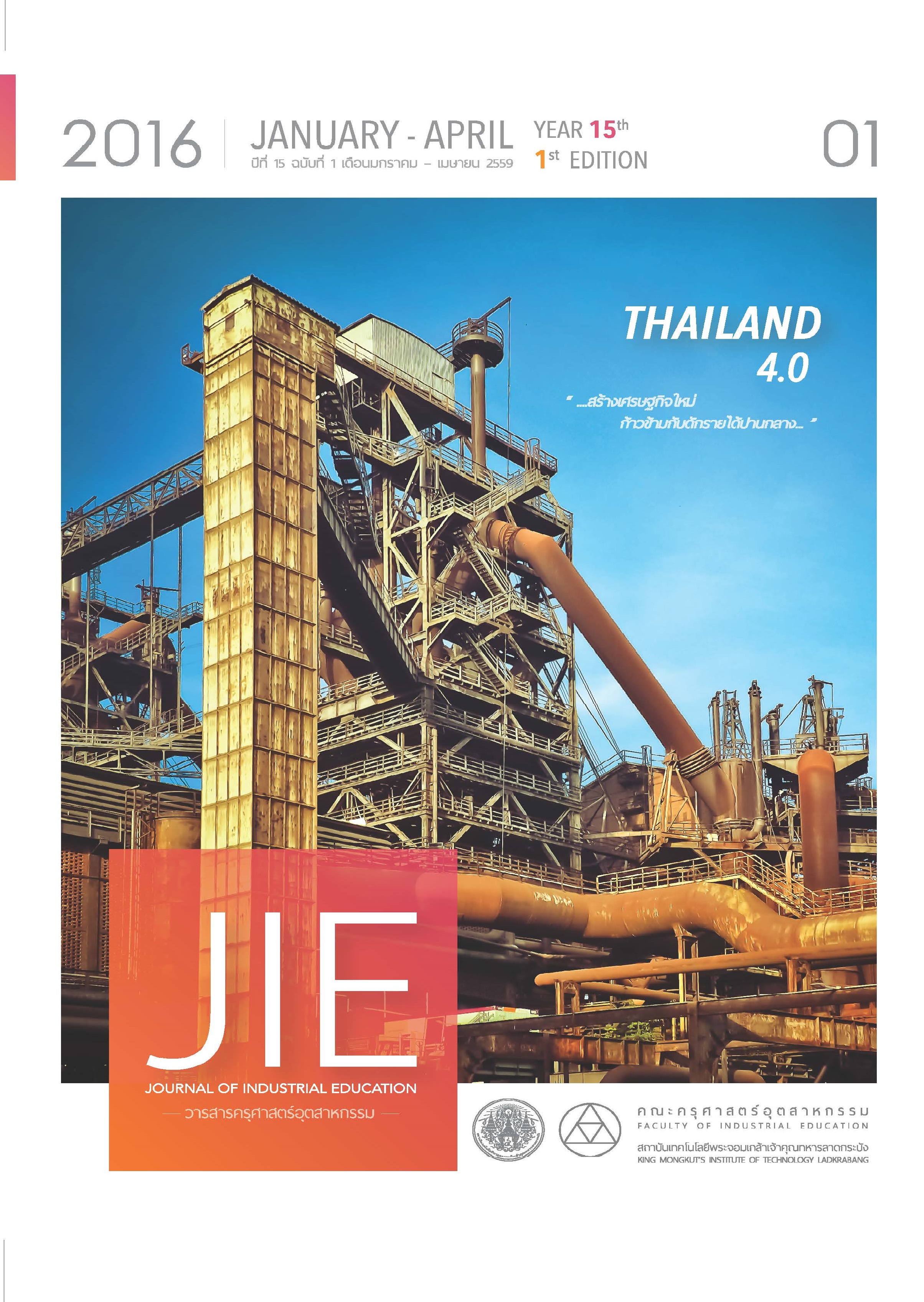THE DEVELOPMENT OF ELECTRIC AUTOMOTIVE SYSTEM PACKAGE OF VOCATIONAL CERTIFICATE STUDENTS IN AUTOMOTIVE PROGRAM
Keywords:
skill package, electric automotive system exercises, achievement test, develop skill package, Vocation certificate level studentAbstract
The purposes of this research were to; 1) develop and find out effectiveness of electric automotive system package of vocational certificate students in automotive program, and 2) compare achievement between students learning with electric automotive system package of vocational certificate students in automotive program and students learning with regular program. The samples 56 people were diploma students in automotive program of Academic year 1/2558 were recruited by cluster random sampling. Duration of study took 6 weeks. The research tools were consisted of 1) Eelectric automotive system package of Vocational, 2) evaluation forms on content and media production techmique, 3) achievement test on knowledge and practices with content validity level (IOC) between 0.80–1.00, difficulty level between 0.50-0.78, discrimination level between 0.22-0.67, reliability level was 0.72, electric automotive system performance Test. with content validity level (IOC) between 0.80–1.00 and inter-rater reliability at 0.90 Mean, standard deviation and dependent t-test was used for data analysis.
The results of the study were as follows,
1) Electric automotive system package had efficiency at 72.22/80.46. according to the set criteria.
2) Students learning with electric automotive system package had post test score higher than those pretest; having the significance level of 0.05.
References
[2] สถาบันทดสอบทางการศึกษาแห่งชาติ(องค์การมหาชน). 2557. กรุงเทพฯ
[3] สถาบันเทคโนโลยีพระจอมเกล้าพระนครเหนือ. 2543. การออกแบบและสร้างต้นแบบชุดทดลองและชุดสาธิต. กรุงเทพฯ : สำนักพัฒนาเทคนิคศึกษา.
[4] Wilson , James W. 1971. “ Evaluation of Learning in Secondary School Mathematics” in Handbook on Formative and Summative Evaluation of Student Learning . Benjamin S. Bloom editor. New York: McGraw – Hill Book Company.
[5] ชัยยงค์ พรหมวงศ์. 2521. นวัตกรรม และเทคโนโลยีทางการศึกษาการสอน. กรุงเทพฯ : ไทยวัฒนาพานิช.
[6] พรรณี ลีกิจวัฒนะ. 2553. วิธีการวิจัยทางการศึกษา (พิมพ์ครั้งที่ 6). กรุงเทพฯ : คณะครุศาสตร์อุตสาหกรรม สถาบันเทคโนโลยีพระจอมเกล้าเจ้าคุณทหารลาดกระบัง.
[7] Bloom,Benjamin S . (1964). Taxonomy of Educational Objectives:The Classification of Educational Goals. Handbook ll Affective Domain. London:Longman.
[8] ขอบคุณ ไชวงศ์. 2552. การพัฒนาชุดทดลองวิชาวงจรดิจิตอลเบื้องต้นโดยการใช้ CPLD สำหรับหลักสูตรประกาศนียบัตรวิชาชีพ ชั้นสูงมหาวิทยาลัยเทคโนโลยีราชมงคลอีสาน.นครราชสีมา : มหาวิทยาลัยเทคโนโลยีราชมงคลอีสาน.
[9] ไพบูลย์ พวงวงศ์ตระกูล. 2555. การสร้างชุดทดลองการเขียนโปรแกรมภาษาซีด้วย SDCC บน MCS-51. วารสารครุศาสตร์ อุตสาหกรรม, 11(3), น. 68-73.
Paiboon, P. 2012. A Construction of C Programming Laboratory Set with SDCC on MCS-51. Journal of Industrial Education, 11(3), p. 68-73.
[10] ทิศนา แขมมณี. 2554. ศาสตร์การสอนองค์ความรู้เพื่อการจัดกระบวนการเรียนรู้ที่มีประสิทธิภาพ. กรุงเทพฯ : สำนักพิมพ์แห่งจุฬาลงกรณ์มหาวิทยาลัย.
[11] ปรียา เฉิดโฉม. 2550. รายงานการพัฒนาทักษะการอ่าน การเขียนและหลักการใช้ภาษากลุ่มสาระการเรียนรู้ภาษาไทย ชั้นประถมศึกษาปีที่ ๒ โดยใช้แบบฝึกเสริมทักษะ. กระบี่ : โรงเรียนบ้านนาปง.
Downloads
Published
How to Cite
Issue
Section
License
"The opinions and contents including the words in papers are responsibility by the authors."
"ข้อคิดเห็น เนื้อหา รวมทั้งการใช้ภาษาในบทความถือเป็นความรับผิดชอบของผู้เขียน"



